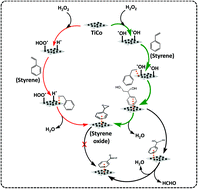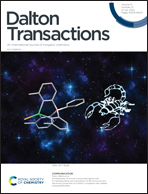TiO2 supported cobalt oxide for olefin epoxidation reaction – characterization, catalytic activities and mechanism – using a DFT model†
Abstract
Metal oxide catalysts are known to trigger C–H bond activation selectively, indicating their suitability for olefin epoxidation. Nano-structured Co3O4 supported on TiO2 was prepared for selective epoxidation of a number of olefins under optimized reaction conditions. An appropriate synthetic procedure yielded a catalytic material (Co–Ti (NP)HT) with desired crystal size and interface conditions. Incorporation of Co into the Ti matrix resulted in an enhancement in the specific surface of Ti–Co nanoparticles (77.93 m2 g−1). XPS measurements evaluated the surface cobalt atom concentration (5.77%) in Ti–Co(NP)HT, indicating more dispersion of cobalt oxide species. Catalytic application of the material, using various olefins (under optimized reaction conditions) shows higher conversion (>85%) in a 6-h time interval. The substrate : oxidant (H2O2) concentration in an optimized molar ratio of 1 : 2 shows high olefin conversion for the formation of olefin oxide. The reactivity of olefins was found to be in the order: cyclohexene > methylstyrene > styrene > chlorostyrene > p-nitrostyrene. A DFT model compared the HOMO–LUMO energies of styrene and its substituted forms. The reusability of Ti–Co (NP)HT tested up to four continuous cycles of batch operations indicates a negligible loss (0.25–0.30%) of catalytic activity.



 Please wait while we load your content...
Please wait while we load your content...